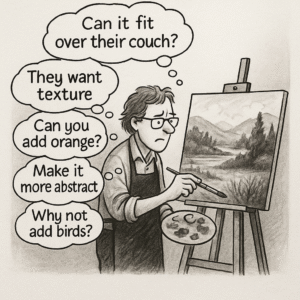For experienced festival artists, the cycle of the art show season often becomes second nature — from applications and booth planning to engaging with patrons and wrapping u p on Sunday evening. Yet amid this routine lies one of the most valuable tools for long-term success: live, unfiltered audience feedback.
p on Sunday evening. Yet amid this routine lies one of the most valuable tools for long-term success: live, unfiltered audience feedback.
Over the course of a weekend, countless small moments unfold: a passing comment about size, a question about price, or a subtle pause in front of one particular piece. While it’s easy to dismiss these as minor or anecdotal, over time they reveal patterns — and within those patterns lie opportunities to refine your offerings and expand your creative impact.
The most successful artists treat festivals not only as sales opportunities, but as research opportunities. Listening deeply to your audience — not just what they say to you, but what they say to each other or murmur as they browse — can yield powerful insights. When someone says, “I love this, but I don’t have the wall space,” that’s not a rejection. It’s a request. When another comments, “I wish there was a smaller version of this,” you’re hearing the beginnings of a product idea.
Similarly, watching what draws people in — and what doesn’t — is as important as making the sale. Which pieces get photographed? Which ones prompt storytelling? Which ones never seem to get a second look? These trends, especially when consistent across multiple shows, can inform decisions about which collections to continue, adapt, or retire.
Direct feedback can be even more powerful when invited. Asking questions such as, “Do you find yourself drawn more to statement pieces or smaller groupings?” creates space for dialogue. The goal isn’t to build your business solely on public opinion, but rather to shape it through informed awareness of your audience’s needs and desires.
Still, one of the biggest mistakes artists make is interpreting this feedback too literally. The idea is not to chase every whim or try to please everyone — that only leads to diluted work. Instead, the most powerful product shifts come when you filter what you hear through your own aesthetic and creative sensibility. If your originals are out of budget for many collectors, perhaps a thoughtfully curated line of small prints or limited editions could invite more people into your world without compromising your brand. If a particular motif resonates, maybe you explore it in a new material or scale. The key is to expand your voice, not replace it.
All of this begins with intentional reflection. After each event, take time to jot down what you observed. To make this easier, I have created a printable Patron Feedback Tracker that you can bring to your show. Keep it in your show binder or sketchbook and use it to log comments, track interest, and document emerging ideas in real time. This tool becomes a living document: a reference not just for troubleshooting weak spots, but for envisioning future work that’s both personally meaningful and market-aware.
Turning feedback into art is a uniquely nuanced skill. But when done thoughtfully, it ensures your next new piece isn’t just a shot in the dark — it’s a resonant evolution, shaped by real human interaction and grounded in purpose.
